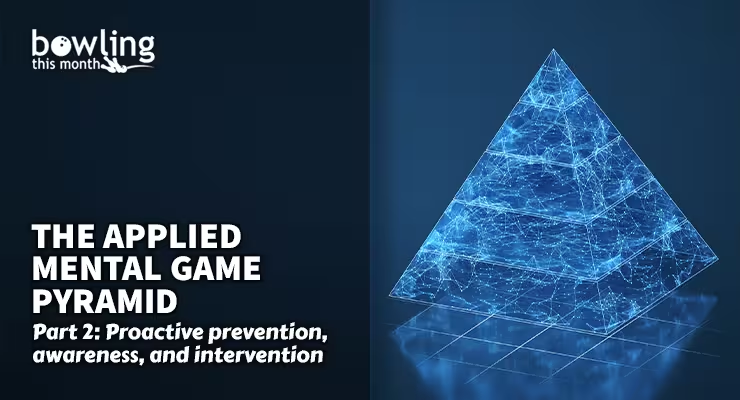Article Contents
- 1. A quick review
- 2. Proactive prevention
- 2.1. The importance of body language
- 2.2. Quiet eye targeting under stress
- 3. Awareness
- 4. Intervention
- 5. Additional strategies
- 6. References
Note: This article is only available to Bowling This Month subscribers.
From my bowlers ending a championship in tears of disappointment to sharing in the joy of one of my athletes standing on the podium to hear their national anthem, I have had a front-row seat for the good, the bad, and the ugly of mental game performances.
From these experiences, I wanted more athletes to perform at their best when it matters most. Accordingly, I developed a six-level applied mental game model consisting of three in-training domains and three in-competition domains. I refer to this as the Applied Mental Game Pyramid.
This pyramid has been presented as a two-part series, and I started by sharing insights into the foundational in-training domains of knowledge, simulation, and anticipation. The first article provided recommendations on applied sports psychology methods for training to prepare for competition.
In this article, I continue sharing the Applied Mental Game Pyramid by discussing the in-competition domains of proactive prevention, awareness, and intervention to guide athletes to reach their best during tournament play.
The stress associated with major competitions can overwhelm an athlete, including those who have spent considerable time in mental game preparations. Accordingly, I present intervention strategies to help you perform at a higher level when it matters most.
A quick review
Let’s begin by reviewing the Applied Mental Game Pyramid. The three in-training domains of knowledge, simulation, and anticipation are from the foundational base of the pyramid:
- Knowledge is the basic understanding of how stress impacts the body. Bowlers must also incorporate individual characteristics and an understanding of their emotional states, both helpful and unhelpful.
- Simulation is the act of reproducing competitive stress in the training environment. An example of this is practicing in an area of the lane you are initially uncomfortable with to create more comfort in case that zone is needed in competition.
- Anticipation is simply preparing for all scenarios by thinking about potential situations and how you intend to respond to them.
These three activities form the foundation of the pyramid. Upon this foundation, a bowler can build the …
Click Here to Read the Full Original Article at Bowling This Month…
